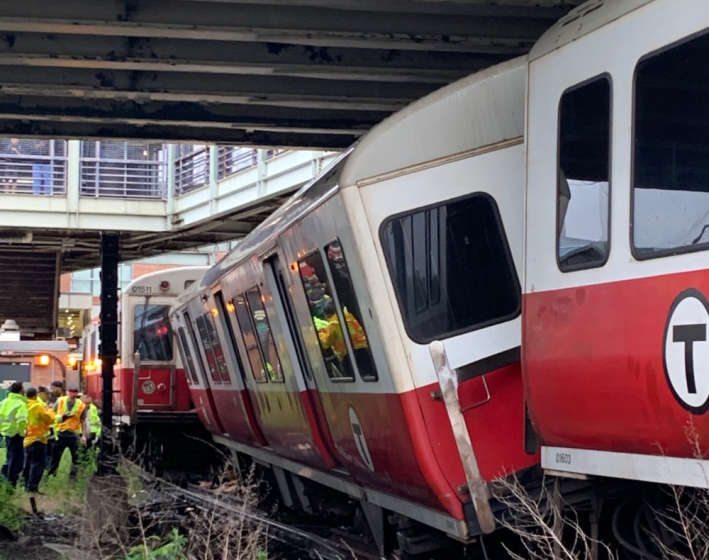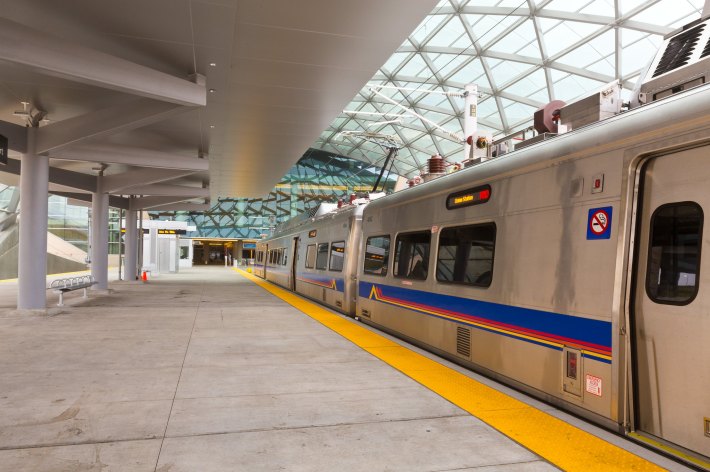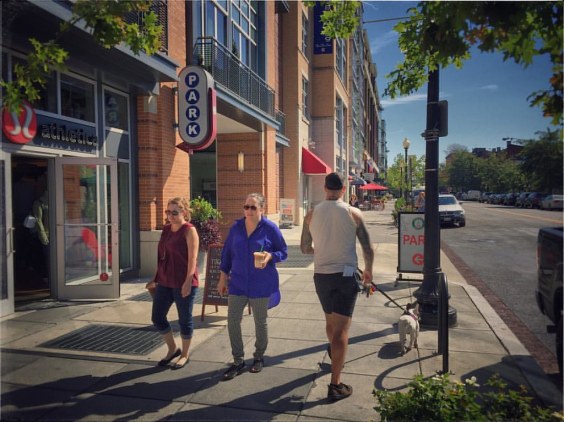MassBudget is a nonprofit think tank that conducts research and analysis on economic and budget policy in Massachusetts, with a particular focus on improving the lives of moderate- and low-income residents. This guest post is part of a MassBudget series looking ahead at some major stories to watch for in the Fiscal Year (FY) 2021 budget debate. StreetsblogMASS will share additional briefs and analysis from MassBudget as new budget proposals are released by the Governor and legislative bodies.
In Massachusetts, people express frustration with their commutes regardless of their mode of transportation. But a better commute and better connections between communities are achievable. Modernizing the way we move people and goods around would boost prosperity and efficiency. It also would reduce pollution and improve access for those often cut off from opportunity. Various plans are underway to improve transportation across the Commonwealth — but they have been held back by lack of funding.
As we prepare for the Governor’s proposal, which kicks off the Fiscal Year (FY) 2021 budget season, MassBudget is publishing a series of briefs that look ahead at some of the major stories to watch in the FY 2021 budget debate. This one explores how lawmakers may respond to the myriad transportation challenges facing the Bay State in the upcoming budget debate.
(Throughout this brief, you will see words in bold. These terms are defined in a glossary at the end of the report.)
How has the conversation about transportation changed?

A lot has happened with transportation since the Governor’s budget proposal last year. A year ago, budget debates about transportation were divided between those who believed problems could be addressed through management reforms and those urging that additional resources were needed. The conversation has turned sharply toward the latter. The problems have become harder to deny; momentum has built for unfunded investments; and proposals for additional funding have advanced:
Undeniable problems – The MBTA’s governing Fiscal Management and Control Board no longer asserts that the MBTA can balance its budget without additional funds. A series of train derailments, signal failures, and power problems across the subway system have underscored an inadequate pace of repair and modernization. In December, an outside panel of national transportation experts issued a stinging report that the MBTA has emphasized cost-cutting at the expense of safety. Separately, a major safety scandal at the Registry of Motor Vehicles (RMV) was tied to an inability to cover other functions while staff were focused on improving Registry wait times. The pressure to improve the transportation system was compounded by a national study that said traffic congestion in Greater Boston is the worst in the country.
Momentum for unfunded investments – Governor Baker proposed a transportation bond bill in July that could support as much as $18 billion in capital investments across all modes of transportation over the next five years, through borrowing against future revenues.
The Governor’s proposal would mostly support state roads and bridges, including $1.25 billion for bridge repair funded by borrowing against future federal funding for the state’s highways. Outside of the Governor’s July bond bill, the MBTA’s governing board in November directed the authority to transform the commuter rail service into a system more like subway service. This means more frequent train service throughout the day; faster electrified service; and lower fares. To begin making these changes on the first three rail routes, the MBTA is instructed to create a rail transformation office and separately a bus transformation office. In addition to these, the MBTA is promising ‘revolutionary’ improvements to meet specific subway speed and reliability benchmarks in the coming years.
Finally, the transit authority also is considering discount MBTA fares for low-income riders, while an emerging discussion of fare-free bus transit is taking place in earnest. Last year, discussion of such discounts seemed remote and was put off until after a new automated fare system would be in place. The new fare collection technology has been delayed years into the future, and several MBTA board members and transit advocacy groups are saying that affordable fares can’t wait.
Proposals for new revenue – A year ago, new revenue for transportation wasn’t under discussion, but several initiatives have since put specific, new sources of transportation funding on the table. The Massachusetts House Speaker pledged to propose additional taxes or fees to fund transportation. An array of business and civic groups proposed packages of user fees or corporate taxes for greater investment in the transportation system. Governor Baker has meanwhile helped lead commitments among Northeast governors to collect future carbon fees on wholesale gasoline that could reach $500 million annually in Massachusetts from a Transportation Climate Initiative that would make investments to reduce transportation emissions. The Administration also proposed an increase in real estate transfer fees to fund the resilience of infrastructure in the face of worsening climate change.
Six items to look out for in the Governor’s transportation budget
- Will there be investment in new capital contracting capacity?For five years the Administration has urged against major, new transportation revenues by saying it would have trouble properly spending funds until it has improved its capacity to do so. Early in the Baker Administration, large numbers of staff left the Department of Transportation (MassDOT) and the MBTA through early retirement initiatives. These agencies have since struggled to recruit more staff at existing salaries to oversee new capital contracts. The Governor’s budget could indicate how hard the Administration will push to improve its staffing and other capacity to deliver on capital investment.Authorizing new bond financing, such as in the Governor’s transportation bond bill, doesn’t ensure additional money for bridge, highway, or transit unless the Administration takes the next step of then issuing the bonds for their designated purposes. Typically, a sizeable share of transportation bonding authority hasn’t been appropriated (issued for a designated purpose) because the Administration is unable to meet the requirements, decides not to pursue the project, or some other reason. If the agencies succeed in hiring additional staff, it will likely require additional funds, potentially through the Massachusetts Transportation Trust Fund (line item 1595-6368 in the state budget).

In the wake of a high-profile and dangerous Red Line derailment in the summer of 2019, the Governor convened a Safety Review Panel of national experts to assess the state of the MBTA. Will the budget proposal include new commitments in response to the panel’s alarming findings? Among other things, the panel found that: “Deep budget reductions have resulted in the lack of resources in critical areas, which may be affecting the safe delivery of services,” and “there is a general feeling that fiscal controls over the years may have gone too far, which coupled with staff cutting has resulted in the inability to accomplish required maintenance and inspections, or has hampered work keeping legacy system assets fully functional.”
The supplementary budget in December included $32 million as a down payment for operations and the Governor has requested an additional $18 million in tying off the FY 2020 budget. Annual state support of the MBTA operating budget (line item 1595-6369) had been $187 million (not adjusted for inflation) in fiscal years 2016 and 2017 until the Administration began redirecting $60 million each year to the capital fund.It will be interesting to see whether the Administration continues to divert these funds or whether it maintains this money for regular operations. The Administration could point to increased funding for the MBTA without taking any new action by relying on automatic increases to the agency from the sales tax, which in November was bringing in almost $30 million more than anticipated.
 Following interest from the MBTA’s board, the Governor’s budget could provide additional funds to help introduce a discounted transit fare program (by offsetting the reduced MBTA revenue from lower fares). An MIT study found that lower transit fares would enable low-income passengers to take 30 percent more trips to professional, health, and personal destinations.Another way to improve service would be to end fare collection on buses, as the Boston Globe has called for. Lawrence has seen 20 percent ridership gains from eliminating fares on some major bus routes. Worcester is also considering doing so, following Kansas City.
Following interest from the MBTA’s board, the Governor’s budget could provide additional funds to help introduce a discounted transit fare program (by offsetting the reduced MBTA revenue from lower fares). An MIT study found that lower transit fares would enable low-income passengers to take 30 percent more trips to professional, health, and personal destinations.Another way to improve service would be to end fare collection on buses, as the Boston Globe has called for. Lawrence has seen 20 percent ridership gains from eliminating fares on some major bus routes. Worcester is also considering doing so, following Kansas City.Eliminating fare collection would increase ridership, enable speedier all-door entry, and allow staff to move from money counting or servicing fare boxes to other jobs that improve service and reliability. According to a recent study, eliminating bus fares would cost the MBTA about $36 million in forgone revenue, an estimate that excludes the Silver Line or long-distance express buses, and assumes people continue to pay for rail travel connected to bus trips which had been a linked single fare or pass. The Commonwealth could also provide resources to regional transit authorities to study or implement the strategy.
The Administration is not anticipated to get ahead of the House in proposing major, new transportation funding, but it could push forward a particular revenue option or reshape the debate with its own proposal. For instance, the Governor could elevate the option of increasing fees for ride-hailing trips, such as on Uber or Lyft (the fee increase could be greater for unshared rides). Or the Governor could propose a large increase in the Commonwealth’s Earned Income Tax Credit to help offset other regressive transportation user fee increases that might be proposed by the House.
The scandal at the RMV exposed how focusing resources on reducing wait times at the registries led to neglect of other functions. Any new investments in RMV staff or improved systems is unlikely to show up in the Governor’s budget because the Registry funds itself through a portion of the fees it charges for licenses and other services.The RMV could invest in improvements to its systems by retaining more of those fees. The RMV would then contribute less fee revenue to the Commonwealth Transportation Trust Fund (CTF), an off-budget fund that contributes to several transportation entities and is also supported by gas taxes and sales taxes on vehicles. Less RMV revenue transfers could mean less support from the CTF for other transportation functions, but it would be difficult to directly track this in the state budget.
Glossary
Bond authorization: Creating the approval or “authority” for a public entity to sell bonds (as a way to borrow money) for a specific purpose. If the state does in fact issue the bond, it will pay back the bond buyers over several years.
Capital investments: Investment in long term assets such as roads, bridges, or new buses. Capital investments are ordinarily more durable than one year and they tend to be paid for over several years, often through the issuance of bonds or other borrowing.
Corporate taxes: Tax contributions from a business or corporation, often from its profits.
Operating budget: Public support for regular operations, such as filling potholes or paying bus drivers, as opposed to long term assets.
Transportation bond bill: In July 2019, the Governor Charlie Baker filed a bill (proposed legislation) asking for the Legislature’s authorization to issue an $18 million bond (borrowed money) to improve the state’s transportation system. These include improvements to the state’s subway system, improvements to the pavement conditions on state roads, and creation of more pedestrian and bicycle lanes. Issuing a bond, however, is only the first step in funding such improvements. Once the Administration is authorized to issue the bond, they may not go through with doing so. As of Fiscal Year 2019, nearly $29 billion in authorized bonding authority remained unissued.
Transportation Climate Initiative: A regional collaboration of Northeast and Mid-Atlantic states and the District of Columbia that seeks to reduce carbon emissions from the transportation sector (read Streetsblog's previous coverage here).
User fees: Money paid by the user of a particular service or facility. Examples include driver’s license fees, gas taxes, transit fares, and highway tolls.
Phineas Baxandall is a Senior Analyst at the Massachusetts Budget and Policy Center (MassBudget), where he focuses on transportation and public revenue policy.






